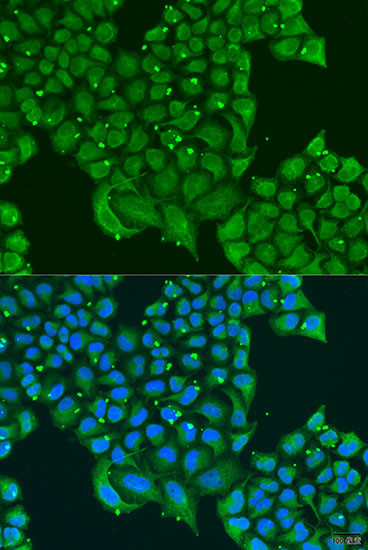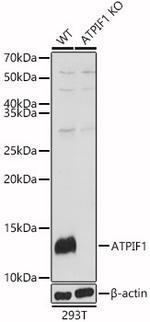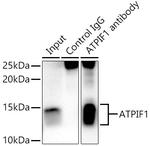Search Thermo Fisher Scientific
Product Details
PA5-92342
Species Reactivity
Host/Isotype
Class
Type
Immunogen
Conjugate
Form
Concentration
Purification
Storage buffer
Contains
Storage conditions
Shipping conditions
RRID
Product Specific Information
Immunogen sequence: GSDQSENVDR GAGSIREAGG AFGKREQAEE ERYFRAQSRE QLAALKKHHE EEIVHHKKEI ERLQKEIERH KQKIKMLKHD D; Positive Samples: MCF-7, 22Rv1, HeLa, H460, Mouse brain; Cellular Location: Mitochondrion
Target Information
Complex V, also called F1F0 ATPase or ATP synthase is extremely conserved through evolution and can be found in plants, fungi, bacteria, and animals. The ATP synthase enzyme is a transmembrane protein responsible for driving the reversible reaction from ADP + phosphate to ATP, in oxidative phosphorylation, and as a proton pumping ATPase. This reaction is accomplished by a flux of protons across the membrane as a result of electron transfer. The enzyme was thought to be localized exclusively to mitochondria; however, it has recently been identified on the plasma membrane of several cell types including hepatocytes where it functions as the HDL receptor, on endothelial cells where it may act as the angiostatin receptor, and on the surface of cancer cells. The ATP synthase protein has two main sections; the F1 ATP-ase (soluble) and the F0 ATP-ase (membrane embedded). The F1 section consists of the alpha, beta, gamma, delta, and epsilon subunits; while the F0 consists of a, b, and c subunits. The enzyme in mammals is composed of 17 subunits, five of which make up the easily detached F1. The remainder subunits are components of two stalk domains and the proton pumping F0 part of the machinery. Two of the subunits of the F0 part are encoded on mitochondrial DNA while the other subunits are nuclearly encoded. Mutations in the mitochondrial-encoded subunits of ATP synthase (Complex V) cause OXPHOS disease.
For Research Use Only. Not for use in diagnostic procedures. Not for resale without express authorization.
References (0)
Bioinformatics
Protein Aliases: ATP synthase F1 subunit epsilon; ATP synthase inhibitor protein; ATPase inhibitor protein; ATPase inhibitor, mitochondrial; IF(1); IF1; Inhibitor of F(1)F(o)-ATPase
Gene Aliases: ATP5IF1; ATPI; ATPIF1; ATPIP; IF(1); If1; IP
UniProt ID: (Human) Q9UII2, (Mouse) O35143
Entrez Gene ID: (Human) 93974, (Mouse) 11983

Performance Guarantee
If an Invitrogen™ antibody doesn't perform as described on our website or datasheet,we'll replace the product at no cost to you, or provide you with a credit for a future purchase.*
Learn more
We're here to help
Get expert recommendations for common problems or connect directly with an on staff expert for technical assistance related to applications, equipment and general product use.
Contact tech support



